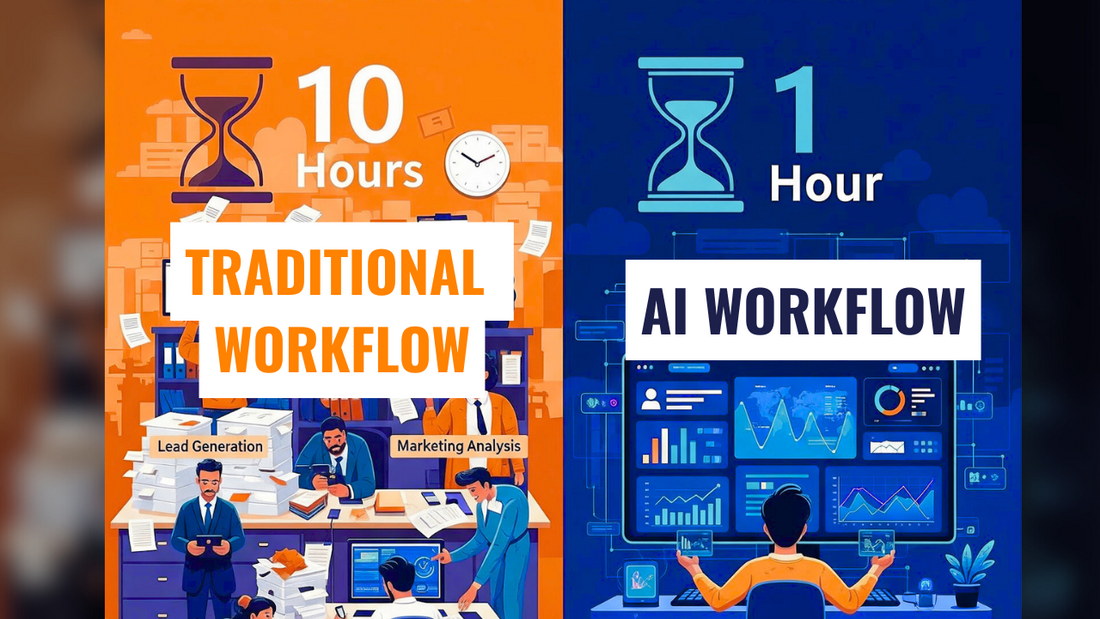AI workflow automation is revolutionizing how businesses operate, making it possible to automate everything from repetitive administrative tasks to complex decision-making processes. As organizations strive to stay competitive in the digital era, leveraging AI-driven workflows is no longer optional—it is essential for sustained success in the rapidly evolving "AI economy.”
What is AI Workflow Automation?
AI workflow automation combines artificial intelligence, machine learning, and process automation tools to streamline business operations. By automating both routine and knowledge-based tasks, companies can dramatically increase efficiency, reduce costs, and empower employees to focus on high-value work.
Key Benefits of Automating with AI
-
Cost Reduction and Efficiency: Integrating hyperautomation technologies with redesigned processes can lower operational costs by up to 30%. AI-driven workflows free employees from manual, repetitive tasks, enabling them to focus on innovation and revenue-generating activities.
-
Enhanced Productivity & Decision-Making: AI replicates human cognitive processes, learns over time, and makes autonomous decisions (with human oversight), maximizing productivity and improving the quality of decision-making.
-
Unmatched Competitive Advantage: Companies that implement tightly integrated AI workflows can scale rapidly, gaining a significant edge in the marketplace.
Core Components of AI Workflow Automation
|
Component |
Description |
|
Process Automation |
End-to-end automation of business processes using RPA, AI, and API integrations. |
|
Intelligent Automation |
AI-powered systems that think, learn, and make decisions autonomously. |
|
Robotic Process Automation |
Automation of repetitive office tasks like data extraction and form completion. |
|
Generative AI |
Creation of original content (text, images, code) in response to prompts. |
|
Low-Code/No-Code Platforms |
Visual drag-and-drop tools for building AI workflows without coding expertise. |
|
Data Fabric |
Unified data management for seamless process orchestration. |
|
Machine Learning |
Algorithms that learn from data to improve accuracy and automate complex tasks. |
|
NLP & OCR |
AI that understands human language and digitizes text from images for automation. |
Practical Applications: How AI Workflows Are Transforming Industries
- Customer Service: AI chatbots and virtual assistants handle routine queries, improving engagement and reducing wait times.
-
Financial Services: AI analyzes transactions for fraud, streamlines document processing, and enhances compliance.
-
Healthcare: Automates appointment scheduling, medical record management, and imaging analysis, improving patient care.
-
Sales & Marketing: AI identifies leads, drafts personalized emails, and automates competitor analysis for faster growth.
-
Content Creation: AI repurposes content, such as converting podcasts into SEO-optimized blog posts, driving organic traffic.
-
Recruiting & HR: Automates resume screening, interview scheduling, and onboarding, reducing costs and improving experience.
- Operations & Supply Chain: AI predicts inventory needs, optimizes quality control, and automates supply ordering.
While the benefits are substantial, organizations must address several challenges to fully realize AI’s potential:
-
Islands of Automation: Avoid disconnected automation silos by adopting a unified platform approach.
-
Initial Setup Complexity: Analyze current processes thoroughly to identify automation opportunities.
-
Employee Concerns: Communicate that AI is meant to augment, not replace, human work, focusing on meaningful tasks.
-
Data Privacy & Reliability: Ensure robust data governance and privacy, especially when handling sensitive information.
Best Practices for Successful AI Workflow Automation
-
Adopt a Platform Approach: Use integrated platforms (like BOAT—Business Orchestration and Automation Technologies) to unify automation efforts.
-
Understand Existing Workflows: Map out current processes to identify bottlenecks and opportunities for automation.
-
Integrate Data Seamlessly: Reliable, unified data is essential for efficient AI workflows.
-
Use the Right Tools: Match automation tools to specific tasks for maximum impact.
-
Involve Stakeholders: Design workflows with input from partners, contractors, and customers.
-
Embrace Continuous Improvement: Treat automation as an ongoing project, constantly seeking enhancements.
-
Upskill Your Workforce: Prepare employees for new roles and responsibilities in an AI-driven environment.
-
Prioritize Responsible AI: Implement transparent, explainable AI for trustworthy decision-making.
The Future: AI Workflows for Knowledge Work
AI is not just for automating routine tasks and is transforming knowledge work by:
-
Elevating Research: Incorporating academic research and high-quality data into workflows for deeper insights.
-
Actionable Insights: Turning theoretical knowledge into practical, easy-to-understand frameworks for business teams.
-
Structured Output: Using advanced LLMs (like Claude or ChatGPT) to generate detailed, actionable plans from curated inputs.
Conclusion: Automate Everything—The Smart Way
AI workflow automation is more than a trend; it is a strategic imperative for businesses aiming to thrive in the AI era. By automating everything—from simple tasks to complex decision-making—organizations can unlock new levels of efficiency, innovation, and growth. Success depends on a unified platform approach, robust data management, a commitment to continuous improvement, and a focus on both operational and knowledge work quality.




